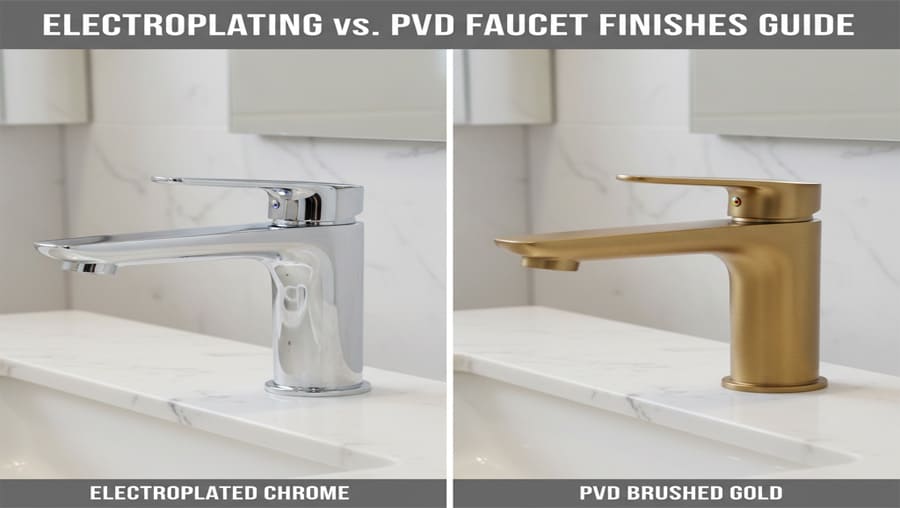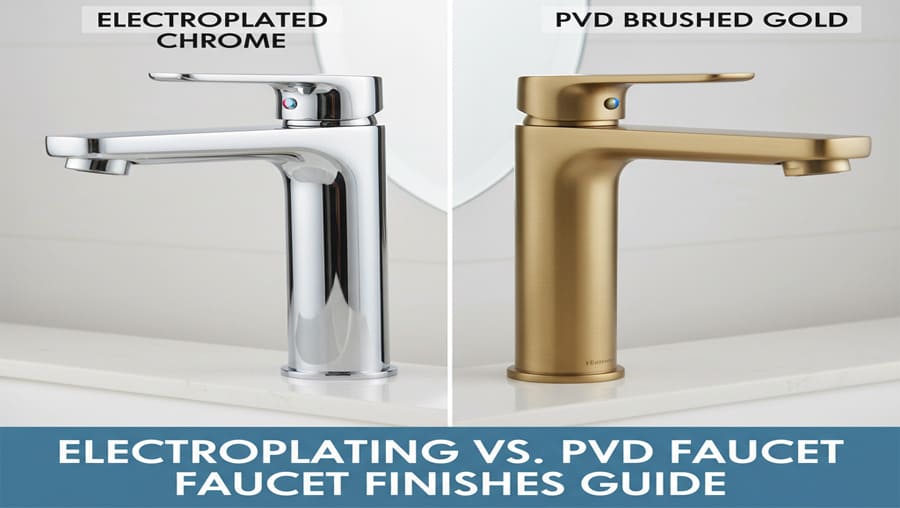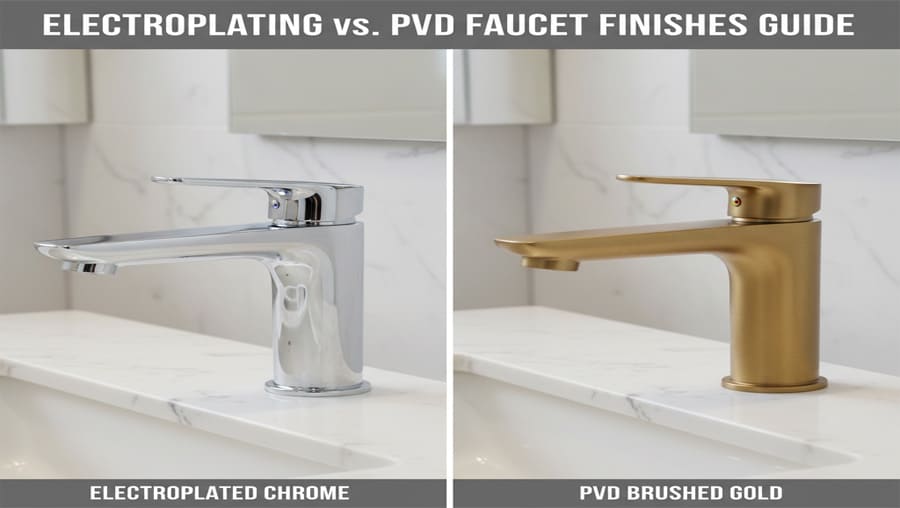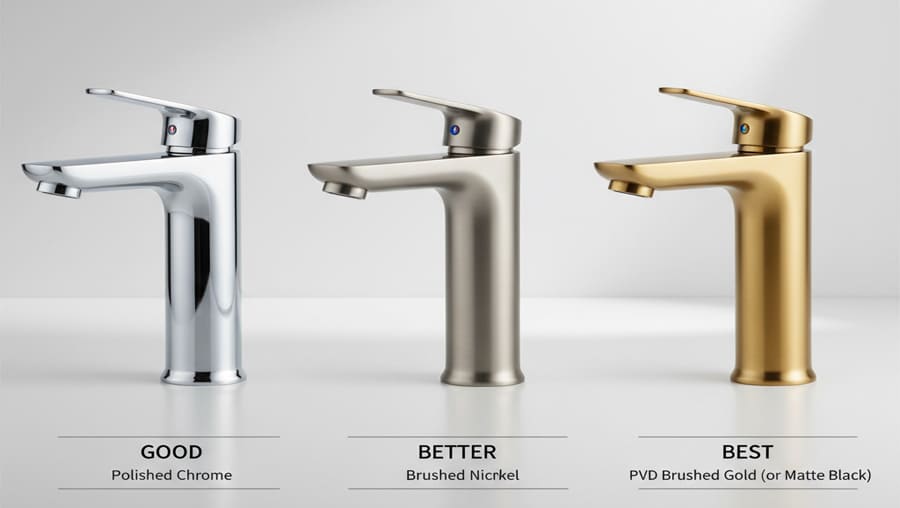When you’re developing a faucet line, the surface finish is far more than just a color choice; it’s a declaration of your brand’s commitment to quality, durability, and style. The two dominant technologies in the industry are traditional electroplating and modern PVD (Physical Vapor Deposition). Understanding the profound differences between these two processes is crucial for you as a brand owner or importer, as this choice will directly impact your product’s performance, cost, and market position. This guide will provide a definitive comparison, helping you make a strategic decision that aligns perfectly with your brand’s promise.
Last Updated: Nov 2025 | Estimated Reading Time: 14 minutes

The Timeless Classic: What is Electroplating?
Electroplating is a wet chemical process with a rich history spanning hundreds of years. At its core, it’s a method of using an electric current to deposit a thin layer of one metal onto the surface of another. For faucets, this isn’t a single coating but a carefully engineered multi-layer system designed to provide corrosion resistance, a brilliant shine, and a durable surface.
The most iconic and globally beloved finish achieved through this method is Polished Chrome. The process for creating a high-quality chrome finish on a brass faucet typically involves three essential layers:
- Copper Layer: The first layer applied to the raw polished brass. It acts as a primer, improving adhesion for the subsequent layers and providing an initial layer of corrosion protection.
- Nickel Layer: This is the most critical layer for durability and corrosion resistance. A thick, high-quality nickel layer is what protects the underlying brass from water and air, preventing oxidation.
- Chromium Layer: The final, extremely thin layer. While it adds some hardness, its primary purpose is to provide the cool, brilliant, blue-white shine that consumers associate with chrome and to prevent the nickel layer from tarnishing.
| Electroplating Layer | Primary Function | What it means for you |
|---|---|---|
| Chromium (Top Layer) | Provides the bright, reflective finish and tarnish resistance. | Delivers the classic, high-shine look that consumers demand. |
| Nickel (Middle Layer) | The workhorse. Provides the bulk of the corrosion and wear resistance. | The thickness and quality of this layer determines the faucet’s lifespan. |
| Copper (Base Layer) | Ensures strong adhesion of the finish to the brass body. | Prevents the finish from peeling or flaking off over time. |
For decades, electroplating has been the undisputed king of faucet finishes, offering a cost-effective way to produce a beautiful and reasonably durable product.
The Modern Powerhouse: What is PVD (Physical Vapor Deposition)?
PVD is a stark contrast to the wet chemical baths of electroplating. It’s a high-tech, dry vacuum deposition process that forms a finish that is molecularly bonded to the faucet’s surface.
Here’s how it works in simple terms:
- Preparation: A faucet (typically made of SUS304 stainless steel or brass) is meticulously cleaned and placed inside a high-vacuum chamber.
- Vaporization: A solid, super-hard coating material, such as Titanium or Zirconium, is vaporized into a plasma of atoms using a high-energy source.
- Deposition: The vaporized metal ions are then deposited, atom by atom, onto the faucet’s surface, where they form an extremely thin, dense, and incredibly hard new surface layer.
Because this new layer is bonded at a molecular level, it’s not really a coating on top of the metal—it becomes an integral part of the metal’s surface. This is the secret to its extraordinary performance.
Real-World Experience: The Steel Wool Test We see the demand for PVD’s durability firsthand. A major US client of ours has a standard procedure for sample approval: they take a steel wool ball and vigorously scrub the surface of the new faucet. For an electroplated finish, this would be a disaster, leaving a web of fine scratches. For a high-quality PVD finish, it does virtually nothing. This simple, brutal test is a perfect demonstration of PVD’s superior scratch resistance and why it’s the choice for premium, high-traffic applications.
Electroplating vs. PVD: The Head-to-Head Comparison
Choosing between these two technologies requires a clear understanding of their respective strengths and weaknesses.
| Feature | Electroplating (e.g., Chrome) | PVD (Physical Vapor Deposition) |
|---|---|---|
| Durability & Scratch Resistance | Good. Can be scratched by abrasive cleaners or sharp objects. | Exceptional. Up to 10-20 times more scratch-resistant than electroplated finishes. Passes the “steel wool test.” |
| Corrosion & Tarnish Resistance | Very Good. A high-quality finish lasts for years. | Exceptional. The molecularly bonded layer is inert and impenetrable, providing the ultimate protection. |
| Color & Finish Options | Limited. Primarily focused on chrome, with options like polished/brushed nickel. | Vast. Can produce a huge range of colors: Brushed Gold, Matte Black, Gunmetal, Rose Gold, Bronze, etc. |
| Unit Cost | Lower. The mature, high-volume process makes it more affordable per unit. | Higher. The complex machinery and process result in a significantly higher cost per faucet. |
| Initial Investment (for a factory) | Moderate. | Extremely High. A PVD vacuum chamber is a multi-million dollar investment. |
| Environmental Impact | Higher. Involves the use of harsh chemicals and produces heavy metal wastewater that requires extensive treatment. | Lower. A “dry,” eco-friendly process with no hazardous waste, making it a more sustainable choice. |
| Maintenance | Easy. Requires non-abrasive cleaners to avoid scratching the chrome surface. | Easiest. The hard surface resists fingerprints and water spots and can be cleaned with almost any standard cleaner. |
A Deeper Dive into Cost: The Shifting Economic Landscape
For decades, electroplating was the clear winner on cost. However, the economic calculation is becoming more complex.
The Rising Cost of Electroplating

The cost of electroplating is directly tied to the commodity prices of the metals used, which are traded on the London Metal Exchange (LME). In recent years, the prices of Nickel (Ni) and Chromium (Cr) have seen significant volatility and a general upward trend. As these raw material costs rise, the unit cost of producing a high-quality electroplated faucet also climbs, eroding its traditional price advantage.
The High Barrier to Entry for PVD
The primary reason for PVD’s higher unit cost is the immense capital investment required. A single industrial PVD coating machine represents a massive upfront cost for a manufacturer. This cost must be amortized over the products they produce, which is why PVD remains a premium option.
| Cost Factor | Electroplating | PVD |
|---|---|---|
| Raw Material Cost | Moderate but volatile (tied to LME Nickel & Chrome prices). | Low per unit, but the coating materials (e.g., Titanium) are specialized. |
| Capital Investment | Established technology, lower equipment cost. | Extremely high, a major barrier for smaller factories. |
| Unit Price for Buyer | Lower, but subject to price increases. | Higher, but more stable. |
| Long-Term Value | Good. | Excellent. The higher initial cost is offset by a much longer lifespan and lower replacement rate. |
Expert Tip: When getting quotes, ask your supplier for pricing on both electroplated and PVD versions of the same faucet. The price difference will immediately tell you where they position the two finishes in terms of value. A smaller gap may indicate a lower quality PVD process.
Strategic Choice: Matching the Finish to Your Brand and Market
There is no single “best” finish. The right choice depends entirely on your brand’s strategy, target customer, and desired market position.
Choose Electroplating (especially Chrome) if:
- You are targeting the mass market or entry-level price points. Chrome’s classic appeal and lower cost make it the unbeatable choice for volume sales.
- Your brand aesthetic is traditional or classic. The brilliant, mirror-like shine of polished chrome is timeless and fits perfectly with traditional designs.
- You are working on large-scale budget-sensitive projects, such as apartment complexes or standard hotels, where reliability and cost are the primary drivers.
- Your primary sales channel is big-box retail, where consumers expect to see familiar, affordable options.
Choose PVD if:
- Your brand is positioned in the mid-to-high-end or luxury market. PVD’s durability and premium feel justify a higher price point.
- You want to offer a wide range of modern, designer finishes. PVD is the only way to achieve durable and consistent colors like Brushed Gold, Gunmetal, and Graphite.
- Your target customer values longevity and performance over initial cost. You can market PVD as a “buy it for life” finish.
- You are supplying high-traffic commercial projects, such as luxury hotels, airport lounges, or upscale restaurants, where faucets must withstand constant use and cleaning.
- Sustainability and eco-friendliness are part of your brand’s core values. PVD’s clean manufacturing process is a powerful story to tell.
Expert Tip: Consider a “Good-Better-Best” strategy. Offer your most popular faucet design in three versions: a “Good” polished chrome (electroplated), a “Better” brushed nickel (electroplated), and a “Best” PVD brushed gold or matte black. This allows you to capture customers at every price point.
Frequently Asked Questions (FAQ)
Q1: Is PVD a new, untested technology? Not at all. While newer to the faucet industry, PVD has been used for decades in other high-performance applications where durability is paramount, such as coating medical implants, high-end watches, and industrial drill bits. Its application in faucets is a proven success.
Q2: Can PVD be applied to any material? PVD can be applied to several materials, but it performs best on a stable, well-prepared substrate. For faucets, it is most commonly applied to SUS304 Stainless Steel, which provides an excellent base. It can also be applied to properly prepared brass, often over a nickel electroplated layer to ensure a flawless surface.
Q3: Will the color of a PVD finish fade over time? No. Because the PVD process creates a hard, ceramic-like, inert surface, it is highly resistant to UV light and oxidation. Unlike some cheaper finishes, a high-quality PVD finish like brushed gold or gunmetal will not fade or change color over its lifespan.
Q4: How can I tell if a faucet has a true PVD finish or a cheaper alternative like lacquer? A true PVD finish feels hard, dense, and metallic to the touch. A cheaper, sprayed-on lacquer or paint will feel softer and can often be scratched with a fingernail. As mentioned in the “Steel Wool Test,” a reputable manufacturer should be confident in their PVD finish’s ability to withstand abrasion. Always request a sample to test yourself.
Conclusion: An Investment in Your Brand’s Reputation
The choice between electroplating and PVD is a strategic one. Electroplating remains the cost-effective, reliable, and universally accepted standard, perfect for capturing the mass market with the timeless appeal of chrome. PVD, on the other hand, is the future—an investment in superior durability, design freedom, and environmental responsibility that positions a brand in the premium tier.
As you plan your product line, don’t just think about the color. Think about the story you want to tell. Is your brand about classic, accessible value? Or is it about cutting-edge performance and lasting luxury? Your answer to that question will lead you directly to the right finish technology, ensuring that the surface of your faucet perfectly reflects the quality and promise of the brand within.
Recommended Links
Internal Links:
- OEM vs. ODM Manufacturing: Which is Right for Your Faucet Brand?
- Why SUS304 Stainless Steel Faucets Are the Smarter Choice
- Top 10 Faucet Manufacturers in China (2025 Buyer’s Guide)
External Links (Authoritative Sources):
- Wikipedia: Electroplating – For a detailed scientific and historical overview of the process.
- Society of Vacuum Coaters (SVC): What is PVD Coating? – An authoritative source explaining the science behind PVD technology.
- London Metal Exchange (LME): Nickel Prices – To track the commodity prices that directly impact electroplating costs.


